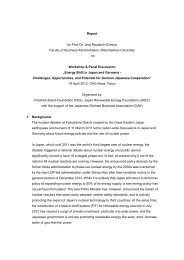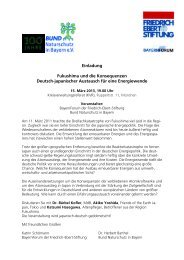Renewable Energy Sources in Figures - Fes-japan.org
Renewable Energy Sources in Figures - Fes-japan.org
Renewable Energy Sources in Figures - Fes-japan.org
Create successful ePaper yourself
Turn your PDF publications into a flip-book with our unique Google optimized e-Paper software.
FOrEWOrDDEaR REaDER,For the tenth year, the Federal M<strong>in</strong>istry for the Environment, Nature Conservation andNuclear Safety has brought out „<strong>Renewable</strong> <strong>Energy</strong> <strong>Sources</strong> <strong>in</strong> <strong>Figures</strong> – National and InternationalDevelopment“. The publication documents the impressive growth of renewableenergies over the past two decades. In 1990, the renewable share of electricity consumptionwas just 3.1 percent, by 2011 this figure was as much as around 20 percent. <strong>Renewable</strong> energiesga<strong>in</strong>ed considerable ground <strong>in</strong> the heat sector too, particularly biomass, which played animportant role <strong>in</strong> the expansion of renewables. Start<strong>in</strong>g at 2.1 percent <strong>in</strong> 1990, the biomassshare rose to 11 percent <strong>in</strong> 2011. Biofuels, which were only used to any significant degreefrom 2000, had a 5.5 percent share of the mobility sector <strong>in</strong> 2011.With its <strong>Energy</strong> Concept of 2010 and the decisions on the transformation of the energy systemtaken <strong>in</strong> June 2011, the German government launched the first comprehensive strategyfor renewables‘ expansion over the com<strong>in</strong>g decades. The aim is to raise their share <strong>in</strong> electricitysupply to at least 35 percent by 2020, and by 2050 renewables are to be the ma<strong>in</strong> pillarof our energy supply, supported by major improvements <strong>in</strong> energy efficiency. The strategywill focus on ensur<strong>in</strong>g supply security, susta<strong>in</strong>ability and affordability. This can succeed if theFederation, the Länder and the local authorities are united <strong>in</strong> a s<strong>in</strong>gle national consensus onenergy.The German government is now work<strong>in</strong>g hard to lay the foundations for successfully transform<strong>in</strong>gthe energy system. The ma<strong>in</strong> task is to better synchronise the development of renewableswith the expansion of the power grids. The German government has also revised the<strong>Renewable</strong> <strong>Energy</strong> <strong>Sources</strong> Act (EEG), ensur<strong>in</strong>g more market options, more competition andgreater cost efficiency. This will keep our transformation of the energy system affordable.This transformation is the most important post-war project for <strong>in</strong>novation. The future successof Germany as an <strong>in</strong>dustrial location will depend on the success of this project. Moreover, it isa project of and for the citizens – and that is why it will succeed.Peter AltmaierFederal M<strong>in</strong>ister for the Environment, Nature Conservation and Nuclear Safety<strong>Renewable</strong> <strong>Energy</strong> <strong>Sources</strong> <strong>in</strong> <strong>Figures</strong>5









